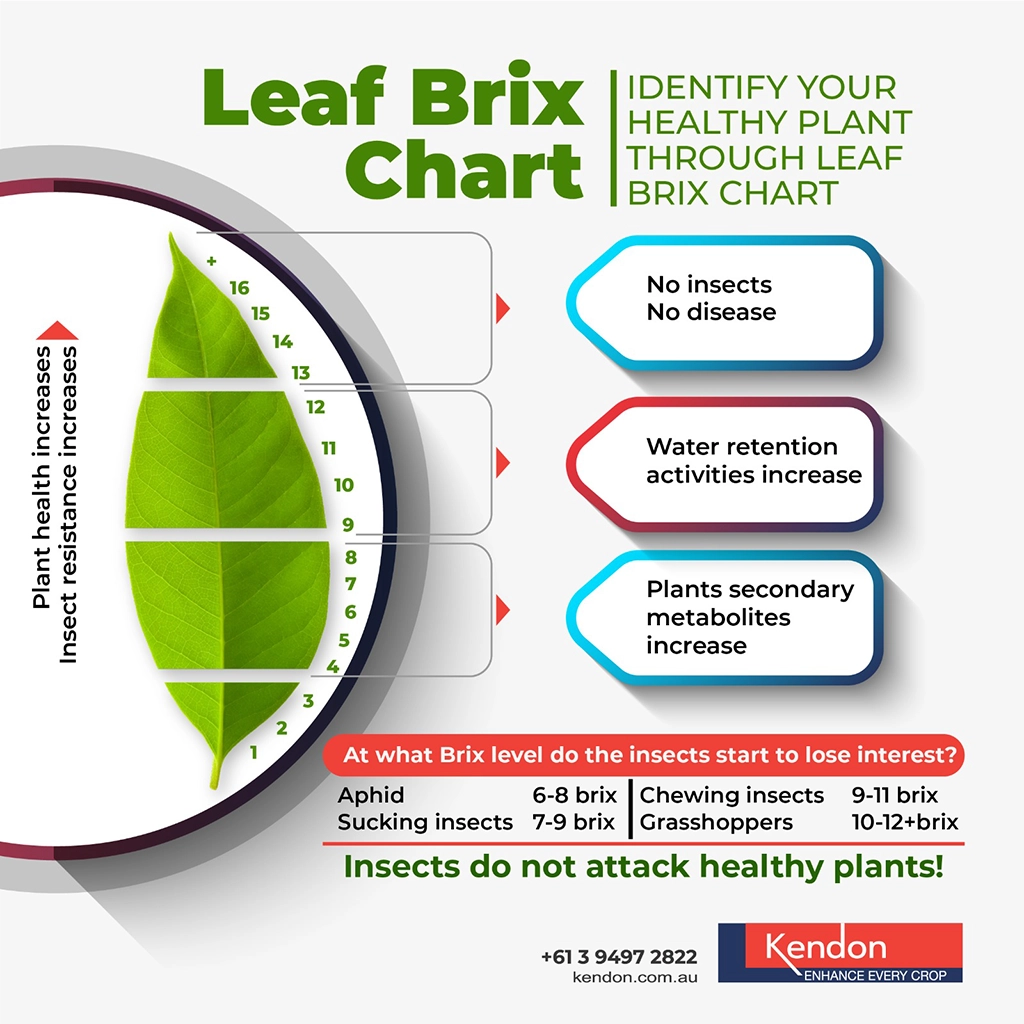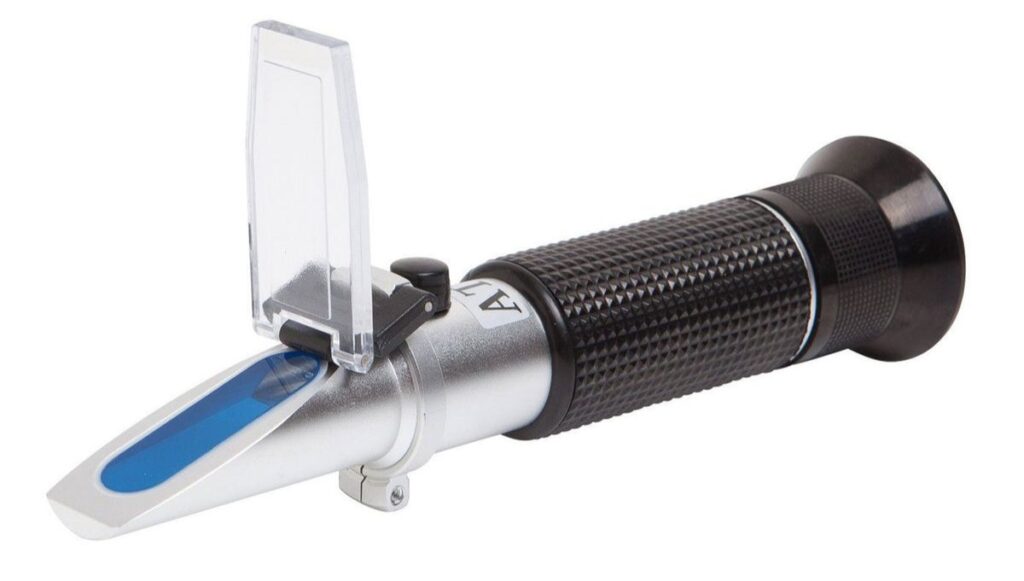Soluble solids (SS) refer to substances that readily dissolve in a solvent to form a homogeneous solution. In plants, these solids encompass a broad range of compounds, including sugars (commonly fructose and glucose) and other organic molecules. Monitoring soluble solids (SS) in leaf sap, measured in degrees Brix (°BX), is gaining traction as a valuable tool in crop production.
While Brix is traditionally used to measure sugar content in fruit, a growing body of research suggests that elevated leaf Brix levels can be associated with improved plant performance, disease suppression, and pest tolerance.
This newsletter highlights recent findings that support the agronomic value of managing leaf Brix to optimise plant health and productivity.

What is Brix and Why Does it Matter?
Brix is a unit of measurement used to quantify the sugar content or concentration of SS in a solution. The Brix scale represents the percentage by weight of SS in a solution. For example, a solution with a Brix value of 10% means that 10 grams of SS are present in every 100 grams of the solution. Brix is commonly measured using a refractometer that calculates °BX based on the bending of light as it passes through the solution. Higher °BX values indicate a higher concentration of SS in a solution.
High Brix levels in leaf sap have been proposed as indicators of plant vigour, with some studies reporting thresholds above which crops are less susceptible to pests and diseases.

Evidence Supporting Brix as a Health Indicator

Dr Carey Reams
The use of Brix (°BX) as an indicator of plant health continues to gain interest across horticulture and viticulture, with a range of historical and recent findings supporting its relevance in crop management.
Back in the 1970s, mathematician Dr. Carey Reams introduced the idea of Brix-based quality thresholds for horticultural crops. He suggested that when crops exceeded certain Brix levels, they were far less prone to disease. For example, strawberries with Brix values above 16°BX reportedly showed no signs of fruit rot (Harrill, 1998).
Even earlier, in the 1950s, research in Californian vineyards found that grape berries with Brix levels over 8°BX became resistant to powdery mildew (Uncinula necator) (Delp, 1954). This led to a practical threshold of 12°BX, after which fungicide applications could be reduced or stopped (Gubler et al., 1989). This finding helped establish a connection between soluble solids, disease resistance, and fruit maturity.
In the 1990s, further anecdotal support emerged. The Peaceful Valley Farm Supply Main Catalog (1993–94) reported that “a Brix reading above 12 indicates plant resistance to sucking insects,” and suggested that sap with higher sugar content becomes too thick for these pests to feed on (Mayse et al., 1997).
More recently, entomologist Dr. Thomas Dykstra has renewed attention on Brix as a pest management tool. While his recommended Brix thresholds for different insect groups are based largely on field experience, they are gaining widespread interest among growers. In Australia, Dr. Mary Retallack has incorporated Dykstra’s thresholds into a broader ecological framework, combining Brix monitoring with leaf nutrient data to support sustainable grape production (Retallack, 2024).
Several scientific studies also support these concepts:
- Douglas firs with higher sugar levels in new foliage were more resistant to budworm attacks (Choristoneura occidentalis) (Clancy, 1992).
- In maize, varieties with higher leaf Brix (around 16°BX) showed greater resistance to the spotted stalk borer (Chilo partellus) (Niazi et al., 2014).
- In cut roses, even modest increases in Brix at low levels (under 1°BX) were associated with larger flower blooms (In & Lim, 2018).
- A study on table grapes showed that mite populations were significantly lower in one cultivar (‘Gazne’) with particularly high Brix readings (over 20°BX) (Khederi et al., 2014).
Altogether, these that monitoring and managing Brix levels—especially in leaf sap—could be a powerful tool for promoting plant health, reducing disease, and improving crop performance.
Leaf Brix Chart by Dr. Thomas Dykstra
Dr. Thomas Dykstra has developed a practical tool known as the Leaf Brix Chart — a simple way for farmers and growers to gauge plant health and predict pest pressure based on sugar levels in the leaves.
The chart is based on the idea that higher sugar levels (measured as Brix) in the leaf sap can make plants stronger and less attractive to pests.
Low Brix: 0 – 3
Plants with Brix levels between 0 and 3 are in serious trouble. At this stage, they lack the metabolic energy to support basic immune functions. These weak plants become easy targets for pests, and disease spreads quickly. Insects move in fast because the plant is essentially defenseless.
Moderate Brix: 4 – 8
Plants in this range show moderate health but are still vulnerable. They may survive, but they won’t thrive. Growth, yield, and resilience are all compromised.
Once Brix climbs to around 6, plants begin producing more secondary metabolites — beneficial compounds that enhance aroma, flavor, and natural pest resistance. At this point, plants are starting to shift from survival mode to self-defense.
High Brix: 9 –11
With Brix levels in the 9 to 12 range, secondary metabolites are in full production. The plant’s natural defenses are now active, and insect pressure begins to drop.
Most sucking insects (like aphids and leafhoppers) lose interest around 8 Brix and move on. However, chewing insects such as caterpillars, beetles, and grasshoppers may still pose a threat — though they generally lose interest as Brix reaches 10 or 11.
Very High Brix: 12–14
At 12 Brix, pest pressure drops significantly. Very few insects will feed on a plant at this level.
However, it’s important to remember that Brix can fluctuate naturally during the season — often by 1 to 2 points — depending on weather, soil, and crop stage. A plant at 12 Brix one week may fall below that the next, briefly opening the door to pests again.
Optimal Brix: 14–20+
To ensure consistent pest resistance, aim for a Brix level of 14 or higher. This gives your plants a buffer against natural fluctuations and keeps them safely above the pest threshold. At this level, plants are typically strong, productive, and well-defended — with virtually no insect issues.
Improving Brix, naturally — The Kendon Approach
At Kendon, we develop our products — particularly Kendon PFF Gold and Kendon High K — with a focus on increasing the Brix level of leaf sap. Higher Brix levels help plants build natural self-defense and unlock their full genetic potential. We are currently running field trials on key crops across Australia and have seen outstanding results. We’re excited to share these findings with you as we move forward.